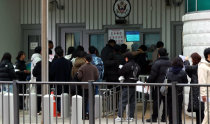Call for immediate action on S. Korea-U.S. integrated nuclear defense strategy
Call for immediate action on S. Korea-U.S. integrated nuclear defense strategy
Posted December. 19, 2023 08:39,
Updated December. 19, 2023 08:39
On Monday morning, North Korea escalated tensions by launching an intercontinental ballistic missile (ICBM), believed to be the solid-fuel Hwasong-18 type, into the East Sea. The missile, launched at a steep trajectory, reached an altitude exceeding 6,000 kilometers and covered a distance of approximately 1,000 kilometers. Experts suggest that if launched on a standard trajectory, this missile could strike targets across the continental United States, spanning over 15,000 kilometers. This launch follows a short-range ballistic missile (SRBM) test conducted the previous night, covering 570 kilometers, marking the first back-to-back missile tests by North Korea this year.
These provocations appear to be North Korea's reaction to the bolstered South Korea-U.S. extended deterrence framework and a demonstration of its military capabilities. In a recent meeting in Washington, D.C., South Korea and the U.S. convened a Nuclear Consultative Group (NCG) to develop nuclear strategy planning and operational guidelines by June next year, addressing potential nuclear threats from North Korea. They also agreed to incorporate these strategies into the upcoming South Korea-U.S. joint military exercises in August, a significant shift from focusing solely on conventional warfare. North Korea, feeling the pressure, has condemned the outcomes of the NCG meeting as a blatant provocation and has threatened a preemptive and devastating response.
The rapid succession of North Korea's missile tests, showcasing both short and long-range capabilities within 10 hours, is seen as an attempt to undermine the U.S. nuclear shield and display its ability to target U.S. strategic interests in the Korean Peninsula and the U.S. mainland. During these tests, North Korea explicitly threatened the U.S. nuclear submarine USS Missouri, stationed in Busan, and claimed the capability to strike the entire U.S. mainland. Notably, North Korea is expediting the development of solid-fuel ICBMs, capable of unexpected attacks, to counter the South Korea-U.S. nuclear strategies.
This latest series of aggressive moves by North Korea, a direct challenge to the South Korea-U.S. joint defense initiatives, has heightened military tensions on the Korean Peninsula, especially in the wake of the dissolution of the 9·19 military agreement between North and South Korea. With the upcoming U.S. presidential election adding a layer of political uncertainty, the regional stability in Northeast Asia is at risk of further destabilization. Traditional deterrents like the threat of "overwhelming retaliation and punishment" are proving less effective against North Korea's aggressive posturing. In response, South Korea and the U.S. must expedite the implementation of their 'integrated extended deterrence' strategy. This includes fast-tracking the formation of a South Korean Strategic Command in alignment with the U.S. Strategic Command and enhancing military response capabilities and cooperative operational systems.







